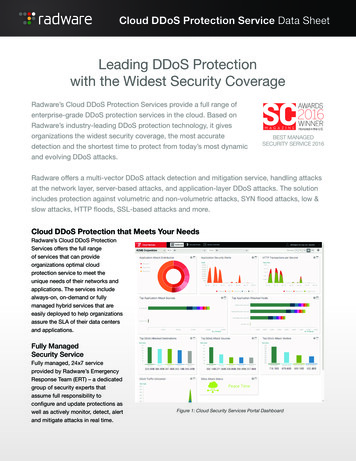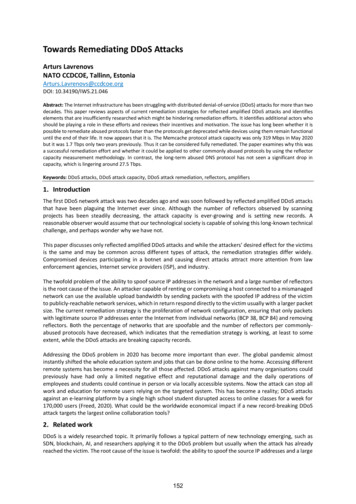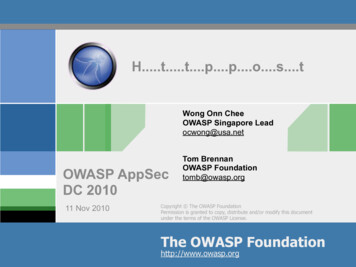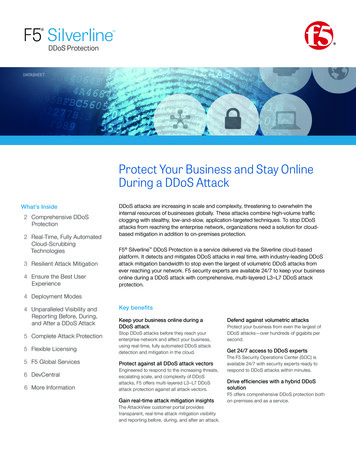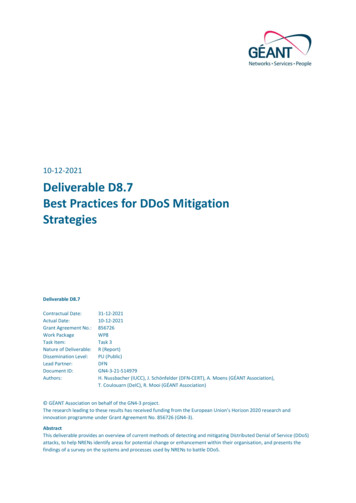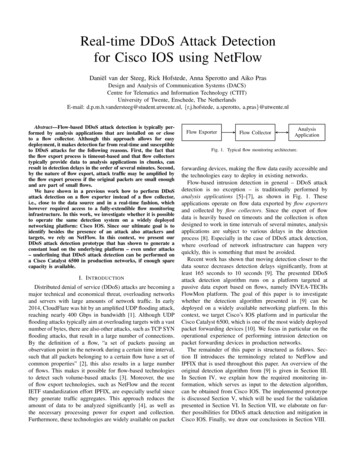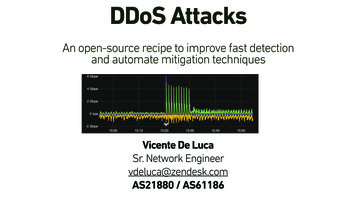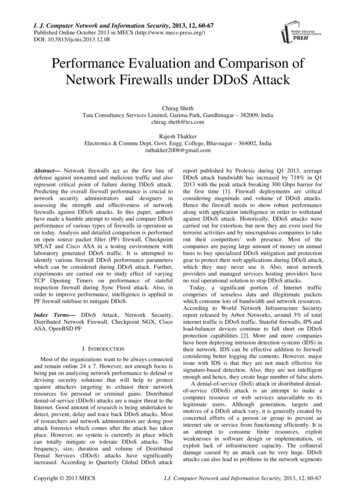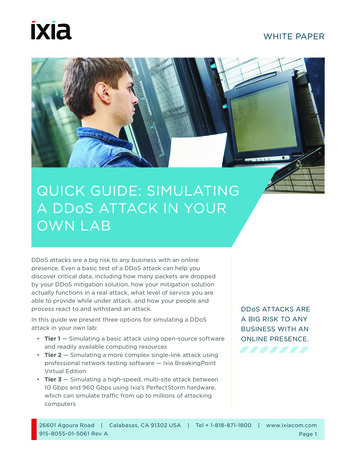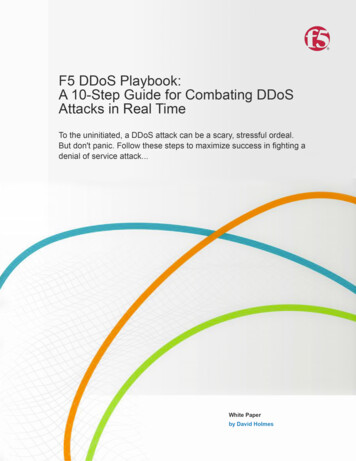
Transcription
WHITEPAPER F5 DDoS Playbook: A Procedural Survival Guide to Combating DDoS AttacksContentsConceptThe Five WorksheetsPreparing for a DDoS AttackDDos-Resilient Architecture3455DDoS Mitigation Steps7STEP 1–VERIFY THE ATTACK8STEP 2–CONFIRM DDOS ATTACK9STEP 3–TRIAGE APPLICATIONS10STEP 4–PROTECT PARTNERS WITH WHITELISTS11STEP 5–IDENTIFY THE ATTACK12STEP 6–EVALUATE SOURCE ADDRESSES MITIGATION OPTIONS13STEP 7–MITIGATE SPECIFIC APPLICATION LAYER ATTACK15STEP 8–INCREASE APPLICATION-LEVEL SECURITY16STEP 9–CONSTRAIN RESOURCES18STEP 10–MANAGE YOUR PUBLIC RELATIONS19Conclusion20Worksheet 1: Contacts List21Worksheet 2: Whitelists22Worksheet 3: Triage Applications23Worksheet 4: F5 Device Map24Worksheet 5: Attack Log252
WHITEPAPER F5 DDoS Playbook: A Procedural Survival Guide to Combating DDoS AttacksConceptDistributed Denial-of-Service (DDoS) attacks are a top concern for manyorganizations today. A DDoS attack creates a security breach with awebsite, saturates the server’s connections, renders its services inoperable,and prevents legitimate clients from being able to connect to it. For theuninitiated, it can be a scary and stressful ordeal!DDoSDDoS attacks are usually coordinated across a large number of clientcomputers (which may have been set up for that purpose), or more likely,have been infected with a virus that allows someone to remotely control thecomputer, making it participate in the attack.Both financially and politically motivated, DDoS attacks are becoming moreprevalent. Although a first attack can happen randomly, it often occurs whenan attacker with specific knowledge of your high-value service, decides totake it off-line. This can cause panic, and instigate costly “ransom-like”decisions to triage and stop the attack.2014DDoSAttack FrequencyFigure 1. Volumetric Attacks Increase in 2014Organizations that have defended against multiple DDoS attacksunderstand the importance of having an objective method to assist incombating them. What is their solution? The F5 DDoS Playbook. This document can be the basis for developing that tool for yourorganization.3
WHITEPAPER F5 DDoS Playbook: A Procedural Survival Guide to Combating DDoS AttacksThe Five WorksheetsThere are five worksheets to complete that will assist you in repelling aDDoS attack. Once completed, these worksheets can be kept in your datacenter and used for reference purposes. Worksheet 1: Contact List–Fill it out as you initiate contacts (page 21). Worksheet 2: Whitelists–Map your partners, users, and services (page 22).If you have not recordedthis informationprior to your first attack,record it as you collect it. Worksheet 3: Application Triage–Know your own applications (page 23). Worksheet 4: Device Map–Create a device map (page 24). Worksheet 5: Attack Log–Note the attack details (page 25).Your organization may have regulatory compliance statutes that require alevel of reporting around cyber-attacks, breaches, or even DDoS attacks.“Worksheet 5: Attack Log” on page 25 can assist you in this situation, as youcan track and refer to the log later during the reporting process.RegulatoryCompliance4
WHITEPAPER F5 DDoS Playbook: A Procedural Survival Guide to Combating DDoS AttacksPreparing for a DDoS AttackDDoS-Resilient ArchitectureIf you are fortunate enough to be reading this document prior to beingattacked, then there are steps that you can take now to make yourapplications, networks, and processes, DDoS-resilient.Network Defense Architecture ConsiderationsAfter you have filled out the worksheets, obtain the F5 DDos RecommendedPractices document so you can consider how to lay out your networkarchitecture defenses.F5 recommends a Multi-Tier Approach DDoS Architecture, where Layer 3 and Layer 4 DDoS attacks are mitigated at the Network Tier, withfirewalls and IP reputation databases (see Figure 2. F5 Recommends aMulti-Tier DDoS Approach Architecture).Multi-Tier ApproachDDoS ArchitectureFigure 2. F5 Recommends a Multi-Tier DDoS Approach ArchitectureThe Application Tier handles high-CPU security functions such as SSLtermination and web-application firewall functionality.Application Tier5
WHITEPAPER F5 DDoS Playbook: A Procedural Survival Guide to Combating DDoS AttacksTo combat DDoS, a modern organization will need a Cloud-based DDoSScrubbing Tier. These service offerings can scrub hundreds of gigabytesper second and return “clean” traffic to the customer data center.DNS is handled in the DMZ and partially protected by the Network Tier.Cloud-based DDoSScrubbing TierDNSThis Multi-Tier Approach can assist in the following attack types andeffects: Defeat TCP connection floods Overcome SNAT port exhaustion Turn back SSL floodsThese are just some of the recommended practices and considerations. Youcan obtain additional resources in the comprehensive F5 DDosRecommended Practices document.6
WHITEPAPER F5 DDoS Playbook: A Procedural Survival Guide to Combating DDoS AttacksDDoS Mitigation StepsIf you appear to be suffering a volumetric attack, it can help to have ahistorical sense of your own traffic patterns. Keep a baseline of normal trafficpatterns to compare against.If you have determined that you are under a DDoS attack, record the“estimated start time” (see “Worksheet 5: Attack Log” on page 25).MonitoringVolumetric Attacks:Remember to keepa monitoring web pageopen to indicate when theattack may be over (ormitigate).You will need to follow up to 10 steps for your DDoS Mitigation: STEP 1–VERIFY STEP 2–CONTACT TEAM LEADS STEP 3–TRIAGE STEP 4–IDENTIFY STEP 5–PROTECT REMOTE USERS STEP 6–EVALUATE SOURCE ADDRESS MITIGATION OPTIONS STEP 7–MITIGATE SPECIFIC APPLICATION ATTACKS STEP 8–INCREASE APPLICATION-LEVEL SECURITY POSTURE STEP 9–CONSTRAIN RESOURCES STEP 10–MANAGE YOUR PUBLIC ERS7
WHITEPAPER F5 DDoS Playbook: A Procedural Survival Guide to Combating DDoS AttacksSTEP 1– VERIFYTHE ATTACKMost outages are not caused by a DDoS attack DNS misconfiguration.Upstream routing issues and human error are some common causes. Youmust first rule out these types of non-DDoS attacks, and distinguish themfrom a common outage.Common OutagesThe faster that you can verify the attack is a real DDoS attack, the faster youcan respond.Even if the outage was not caused by a misconfiguration orother human error, there may still be other explanations that may resemble aDDoS attack.The Slashdot Effect occurs when a particular page on your site is featured ona very popular forum or blog. Your investigation must rule out suchpossibilities.Is there outbound connectivity? If not, then the attack is so severe that it isas congesting all inbound and outbound traffic. Check with your usualdiagnostic tools (traceroute, ping, dig, etc.), and rule out all suchpossibilities.Check the following Internet weather reports to determine if the attack is aglobal issue:Slashdot EffectOutbound ConnectivityGlobal Issue Internet Health Report Internet Traffic ReportAttempt to access your application from an external network. Services thatcan perform this kind of monitoring are:External NetworkAccess Keynote Testing and Monitoring GomezSM –Comprehensive Performance-Monitoring Tool fromCompuware HP SiteScope – Agentless monitoring SolarWinds NetFlow Traffic Analyzer Down for everyone or just me?Check to see if DNS is responding for your website. The following UNIX commandresolves a name against the OpenDNS project server.DNS WebsiteResponse% dig @208.67.222.222 yourdomain.co8
WHITEPAPER F5 DDoS Playbook: A Procedural Survival Guide to Combating DDoS AttacksSTEP 2–CONFIRM DDOS ATTACKContact Team LeadsNow it is time to contact the leads of the relevant teams. If you have not filledout “Worksheet 1: Contacts List” on page 21, fill it out now.When an outage occurs, your organization may hold a formal conferencecall including various operations and applications teams. If your organizationhas such a process, leverage the meeting to officially confirm the DDoSattack with team leads.Contact Your Bandwidth Service ProviderOne of the most important calls you can make is to the bandwidth serviceprovider. They can likely confirm your attack, provide information aboutother customers who might be under attack, and sometimes offerremediation.Contact Your Fraud TeamIt is especially important to invoke the fraud team as soon as the attack isverified. DDoS attacks can be used as “cover” to hide an infiltration. Logsthat would normally show a penetration may get lost during a DDoS attack.This is why using high-speed, off-box logging is so important.The number for yourservice provider shouldbe listed in“Worksheet 1:Contacts List” onpage 21.9
WHITEPAPER F5 DDoS Playbook: A Procedural Survival Guide to Combating DDoS AttacksSTEP 3–TRIAGE APPLICATIONSIf you have not done this exercise yet, now is the time to triage yourapplications.When faced with an intense DDoS attack and limited resources, triagedecisions have to be made. High-value assets typically generate high-valueon-line revenue. These are the applications that you will want to keep alive.Ultimately, these are financial decisions–make them appropriately.Low-value applications, regardless of the level of legitimate traffic, should bepurposefully disabled so that their CPU and network resources can be put tothe aid of the higher-value applications. You may need the input of the teamleads to do this. Record your choices in “Worksheet 3: Triage Applications” onpage 23 for future reference. Decide which applications are low-priority and can be disabled (andthus protected) during the attack. This may include internalapplications.Worksheet 3takes only a few minutesto fill out, and will greatlyassist you in combatingan actual DDoS event.10
WHITEPAPER F5 DDoS Playbook: A Procedural Survival Guide to Combating DDoS AttacksSTEP 4–PROTECT PARTNERSWITHWHITELISTSWhitelist Partner AddressesVery likely you have trusted partners that must have access to yourapplications or network. If you have not already done so, collect the IPaddresses that you must always allow access for and maintain that list. Print“Worksheet 2: Whitelists” on page 22, which includes a template for yourwhitelist collection.You may have to populate the whitelist in several places through thenetwork, including the firewall, the ADC, and perhaps even with the serviceprovider, in order to guarantee that traffic to and from those addresses isunhindered.Protect VPN usersModern organizations will whitelist or provide quality-of-service for theremote SSL-VPN users. Typically this is done at an integrated firewall/VPNserver, which can be important if you have a significant number of remoteemployees.11
WHITEPAPER F5 DDoS Playbook: A Procedural Survival Guide to Combating DDoS AttacksSTEP 5–IDENTIFYTHEATTACKDetermine the Nature of the AttackNow it is time to gather technical intelligence about the attack. The first question that you need to find the answer to is:“What are the attack vectors”?You are trying to determine the nature of the attack itself. Is it: Volumetric–Flood based attacks that can be at Layer 3, 4, or 7? Asymmetric–Designed to invoke timeouts/session-state changes? Computational–Designed to consume CPU and memory? Vulnerability-based–Designed to exploit software vulnerabilities?4 DDoS Attack TypesYou have, by now, called your bandwidth service provider (see “Worksheet1: Contacts List” on page 21). If the attack is solely volumetric in nature, theywill have informed you and may have already taken steps at DDoSremediation.Even though well-equipped organizations use existing monitoring solutions(such as NetScout ) for deep-packet captures, you may find that there arecases where you have to use procure-packet captures from other devices,such as the application delivery controller (ADC) to assist in diagnosing theproblem. These cases include: SSL Attack Vectors. If the attack is launched over SSL, there may beno other way to diagnose it other than at the ADC. Capture thepacket streams either at the ADC or elsewhere, and then use thessldump utility to decrypt the stream file. FIPS-140. If your ADC is using a FIPS-140 hardware securitymodule (HSM), then you can often still use ssldump to decode thefile capture. Use a Mirror-Port or Clone Pool. One way to capture packets is tomirror them from the ADC. This high-performance method allowsdata to flow through the ADC and also to an external device withoutinterruption.12
WHITEPAPER F5 DDoS Playbook: A Procedural Survival Guide to Combating DDoS AttacksSTEP 6–EVALUATE SOURCE ADDRESSES MITIGATION OPTIONSIf Step 5 has identified that the campaign has advanced attack vectors thatyour service provider cannot mitigate (such as slow-and-low attacks,application attacks, or SSL attacks), then the next step is to consider thefollowing question:“How many sources are there”?If the list of attacking IP addresses is small, you can block them at yourfirewall. Another option would be to ask your bandwidth provider to blockthese addresses for you.The list of attacking IP address may be too large to block at the firewall.Each address that you add to the block list will slow processing and increaseCPU. You may still be able to block the attackers if they are all in the samegeographic regions that you can temporarily block.For example, if the majority of your attacks appear to be coming fromSoutheast Asia, evaluate the revenue you will lose if you block all traffic fromthat region. Be deliberate about geo-blocking.Finally, if there are many attackers in many regions, but you don’t care aboutany region except your own, you may also use geo-location as a defense byblocking all traffic except that originating from your region.Geo-blocking:The decision to blockentire regions via geolocation must be madeas a business decision.Mitigating Multiple Attack VectorsIf there are too many attackers to make blocking by IP address or regionfeasible, you may have to develop a plan to unwind the attack by mitigating“backwards” – that is, defending the site from database Tier, to theapplication Tier, to the web servers, load balancers, and then firewalls.You may be under pressure to remediate the opposite way– for example,mitigating at Layer 4 to bring the firewall back up. However, be aware that asyou do this, attacks will start to reach further into the data center.13
WHITEPAPER F5 DDoS Playbook: A Procedural Survival Guide to Combating DDoS AttacksAs you identify the different mix of attack vectors, “Attack Remediation” onpage 16 can assist in showing you exactly where to find the remediationspecific to the individual attacks.Attack VectorFirewallOn-PremisesDDoSApplication DeliveryControllerCloud XTCP-FloodDNS-FloodXXApache KillerXXSlowlorisXXKeep DeadXXHTTP RecursiveGETXXTable 1. Attack Remediation14
WHITEPAPER F5 DDoS Playbook: A Procedural Survival Guide to Combating DDoS AttacksSTEP 7–MITIGATE SPECIFIC APPLICATION LAYER ATTACKSYou have reached this step because the DDoS attack is sufficientlysophisticated to render mitigation by the source address ineffective. Attacksthat fall into this category may be generated by tools such as the “Low OrbitIon Cannon,” the “Apache Killer” or the “bro-bot.” These attacks look like normal traffic at Layer 4, but have anomalies todisrupt services in the server, application or database Tier.To combat these attacks, you must begin enabling or constructing defensesat the application-delivery Tier.Mitigate Specific Attack ToolsYou have analyzed the traffic in Step 4. If it appears to be an applicationlayer attack, the important questions are:Can you identify the malicious traffic?Does it appear to be generated by a known attack tool?Specific application-Layer attacks can be mitigated on a case-by-case basiswith specific F5 countermeasures. Attackers today often use multiple typesof DDoS attack vectors, but most of those vectors are around Layers 3 and4, with only one or two application-Layer attacks thrown in. Hopefully this isthe case for you, which means you are nearly done with your DDoS attack.To learn about eachcommon attack tool andmitigation strategy, see“The Taxonomy ofApplication Attacks” in the“F5 DDoS RecommendedPractices” document.15
WHITEPAPER F5 DDoS Playbook: A Procedural Survival Guide to Combating DDoS AttacksSTEP 8–INCREASE APPLICATION-LEVEL SECURITY POSTUREIf you have reached this step in the DDoS attack, you’ve already mitigated atLayer 3 and 4 and evaluated mitigations for specific application attacks, andyou are still experiencing issues.Asymmetric Application AttackVery likely you are being confronted with one of the most difficult of modernattacks: the asymmetric application attack. This kind of attack can be: A flood of recursive GETs of the entire application. A repeated request of some large, public object (such as a MP4 orPDF file). A repeated invocation of an expensive database query.If you implemented asubset of the architecturalrecommendationsdiscussed in theintroduction, you may beable to make use of thosedefenses now.Leveraging Your Security PerimeterThe best defense against these asymmetric attacks depends on yourapplication. For example, financial organizations know their customers andare able to use login-walls to turn away bad traffic. Entertainment industry applications (such as hotel websites), on the otherhand, often do not know the user until the user agrees to make thereservation. For them, a CAPTCHA might be a better deterrent.Choose the application-level defense that makes the most sense for yourapplication: Login-wall Human Detection Real Browser Enforcement16
WHITEPAPER F5 DDoS Playbook: A Procedural Survival Guide to Combating DDoS AttacksA Login-wall is a logical defense that requires a client to be logged in as aknown user before it can access any high-value asset or run a databasequery. Login-walls can be implemented at a Service Provider, a WebApplication Firewall, or an Application Delivery Controller.Login-wallThe drawback to this otherwise perfect solution is that not every applicationhas a tight integration with known users. For example, hoteliers must serveroom availability applications that do not require the user to login.Human Detection is the second-best approach. Validating that the clientconnection is at least being controlled by a human (instead of a maliciousbot) can go a long way to turning back a Layer 7 DDoS attack. Usually this isdone with a CAPTCHA of some kind.Human DetectionA CAPTCHA is an acronym for “Completely Automated Public Turning testto tell Computers and Humans apart”–it is a challenge used in computing totell whether or not the user is human.The drawback to CAPTCHAs (and thereason that they do not protect every resource all the time), is that they willturn away some percentage of legitimate users. Flexible applications willallow CAPTCHAs to be turned ON during an attack and then OFF againafterward.CAPTCHAsFigure 3. A typical CAPTCHAReal browser enforcement is the third option. Some web applicationfirewalls provide this functionality by inserting a JavaScript redirect to newconnections, and then blacklisting them if they do not follow the redirect.This is a nice approach because it foils the majority of bots withoutinterfering with real users using real browsers.Real BrowserEnforcement17
WHITEPAPER F5 DDoS Playbook: A Procedural Survival Guide to Combating DDoS AttacksSTEP 9–CONSTRAIN RESOURCESIf all the previous steps fail to stop the DDoS attack, you may be forced tosimply constrain resources to survive the attack.This technique turns away both good and bad traffic. In fact, rate limitingoften turns away 90–99% of good traffic while still enabling the attacker todrive up costs at your data center. For many organizations, it is better to justdisable or “blackhole” an application rather than rate-limit it.Rate ShapingIf you find that you must rate-limit, you can provide constraints at both sidesof a multi-Tier DDoS architecture. At Tier 1, where Layer 3 and Layer 4security services reside, use rate shaping to prevent TCP floods fromoverwhelming your firewalls and other Layer 4 devices.Connection limits can be an effective mitigation technique, but they do notwork well with the connection-multiplexing features. The Tier 2 connectionlimits should provide the best protection to prevent too much throughputfrom overwhelming your web servers and application middleware.Connection LimitsFigure 4. Resource Constraints– Tier 1 and Tier 218
WHITEPAPER F5 DDoS Playbook: A Procedural Survival Guide to Combating DDoS AttacksSTEP 10–MANAGE YOUR PUBLIC RELATIONSHacktivist organizations today make use of the media to draw attention totheir causes. Many hackers have been informed that an attack is underway,and may contact the target company during the attack.Financial organizations have policies (related to liability), that prevent themfrom admitting an attack is underway. This can become a sticky situation forthe public relations manager. The manager may say something like: “We arecurrently experiencing some technical challenges, but we are optimistic thatour customers will soon have full access to our on-line services.”Financial OrganizationsReporters, however, may not accept this information (especially if the sitereally does appear to be fully off-line). In one recent case a reporter hascalled a local bank branch manager and asked that person how the attackwas proceeding. The branch manager, who had not received mediacoaching responded: “It’s awful, we’re getting killed!”ReportersIf the DDoS attack appears to be a high-profile hacktivist attack, prepare twostatements:1. For the press. If your industry policies allow you to admit when you arebeing externally attacked, do so and be forthright about it. If policy dictates that you must deflect the inquiry, then cite technical challenges butbe sure to prepare the next statement.2. For your internal staff- for distribution to anyone who might be con-tacted by the press. Your internal statement should provide cues aboutwhat to say and what not to say to media, or even better, simply instructyour staff to direct all inquiries related to the event back to the PR manager and include a phone number.19
WHITEPAPER F5 DDoS Playbook: A Procedural Survival Guide to Combating DDoS AttacksConclusionIf this Playbook information has been helpful, create a custom playbook foryour organization. Include the worksheets in the next section–print them, fill them outand laminate them. Use them to create the start of your physical playbook, or put themon the wall in the data center.As you defend yourself against DDoS attacks, you can refine your playbookand improve the resilience of your applications.20
WHITEPAPER F5 DDoS Playbook: A Procedural Survival Guide to Combating DDoS AttacksWorksheet 1: Contacts ListMany different teams may need to come together to fight a large, hecticDDoS attack. Use this worksheet to collect and maintain the contact information forthe different teams and agencies that might be required during aDDoS Attack. Add rows as necessary.TeamNamePhoneEmailNetwork SecurityThreat IntelligenceApplications DirectorDNS ManagerF5 Professional Services1-888-88-BIG-IPReseller ServicesBandwidth Service ProviderPublic Relations DirectorFraud Team LiaisonFinancial Comptroller21
WHITEPAPER F5 DDoS Playbook: A Procedural Survival Guide to Combating DDoS AttacksWorksheet 2: WhitelistsMaintain the list of IP addresses that must always be allowed access.Addresses that should be included in this list are: External monitoring tools (GomezSM, etc.). Google and the other search engines that you do not want to block. Your own Global Traffic Managers (GTMs)–these will be monitoringyour applications throughout the attack. Vulnerability scanners and your DDoS cloud-scrubbers such asProlexic. Your other cloud service providers service providers (this could belarge checklist). Business partners.IP Address RangeMaps To?External ContactInternal Contact22
WHITEPAPER F5 DDoS Playbook: A Procedural Survival Guide to Combating DDoS AttacksWorksheet 3: Triage ApplicationsFor all applications at the data center: Record a priority decision about whether or not it should be disabled. Record a triage decision. (You can use the priority value to assert adecision like “disabling all applications that are priority 3 or lower”). Add a column for the application owner contact information ifnecessary.A defined set of priorities may enable you to automate tasks. For example,you can write a script to disable (and later re-enable) all applications withpriority 3 or less.ApplicationName1Example ApplicationPriority2TriageDisableAssociatedVirtual Serverdc1-rxspc.example.comLocationBIG-IP2, Rack 5, 192.168.11.523456789101123
WHITEPAPER F5 DDoS Playbook: A Procedural Survival Guide to Combating DDoS AttacksWorksheet 4: F5 Device MapIf you engage F5 professional services to assist the defense (during theDDoS attack), it will be helpful to have a map of available F5 devices withinthe data center.The serial numbers for the BIG-IP will help the engagement, and theremaining information will be helpful to those advising you on defensivestrategies. The %tmsh show sys hardware command provides the serialnumber and the platform type.Keep this information with“Worksheet 1: ContactsList” on page 21.Both of the F5 configuration management solutions, F5 EM and F5 BIG-IQ,gather the device information (minus the location) for you, and may assistyou in filling out this table.F5 ialNumberf5-wtax-exgwLocationData Center 1, DMZ, Rack 5, 192.168.11.5234567891024
WHITEPAPER F5 DDoS Playbook: A Procedural Survival Guide to Combating DDoS AttacksWorksheet 5: Attack LogInformation recorded here can be useful for after-action reporting, lessonslearned, and regulatory reporting requirements.Print out several copies ofthis page and use it as acover sheet for notes takenduring the attack.DDoS Attack LogAttack StartedDate & TimeAttack StoppedDate & TimeFraud Team AlertedDate & TimeIntrusion DetectedDate & TimeAssets Exposed (if any)DDoS Attack Vectors (circle)ICMP UDP TCP DNS HTTPHTTPSAttribution (attackers identified)Source addresses may be turned over to the authorities. If attacking sourceaddresses are isolated to a specific country, the attack may be mitigated viageo-location (see “Step 6–Evaluate Source Addresses Mitigation Options”on page 13).Source Address AnalysisGeo-Location:Source Address:25
WHITEPAPER F5 DDoS Playbook: A Procedural Survival Guide to Combating DDoS AttacksProvide a summary that includes a description of the attack, the mitigationsthat worked, and those that did not work.Include services that were disabled, and their weaknesses.Use that information to evolve your services for the next attack.Attack Summary (complete at end)Geo-Location:Source Address:26
WHITE PAPER F5 DDoS Playbook: A Procedural Survival Guide to Combating DDoS AttacksF5 Networks, Inc.401 Elliott Avenue West, Seattle, WA 98119888-882-4447 nf5j-info@f5.com 2015 F5 Networks, Inc. All rights reserved. F5, F5 Networks, and the F5 logo are trademarks of F5 Networks, Inc. in the U.S. and in certain other countries. OtherF5 trademarks are identified at f5.com. Any other products, services, or company names referenced herein may be trademarks of their respective owners with noendorsement or affiliation, express or implied, claimed by F5. WP-SEC-13307-ddos-protection 0113.27
F5 DDoS Playbook: A Procedural Survival Guide to Combating DDoS Attacks Concept Distributed Denial-of-Service (DDoS) attacks are a top concern for many DDoS organizations today. A DDoS attack creates a security breach with a website, saturates the server's connecti ons, renders its services inoperable,
